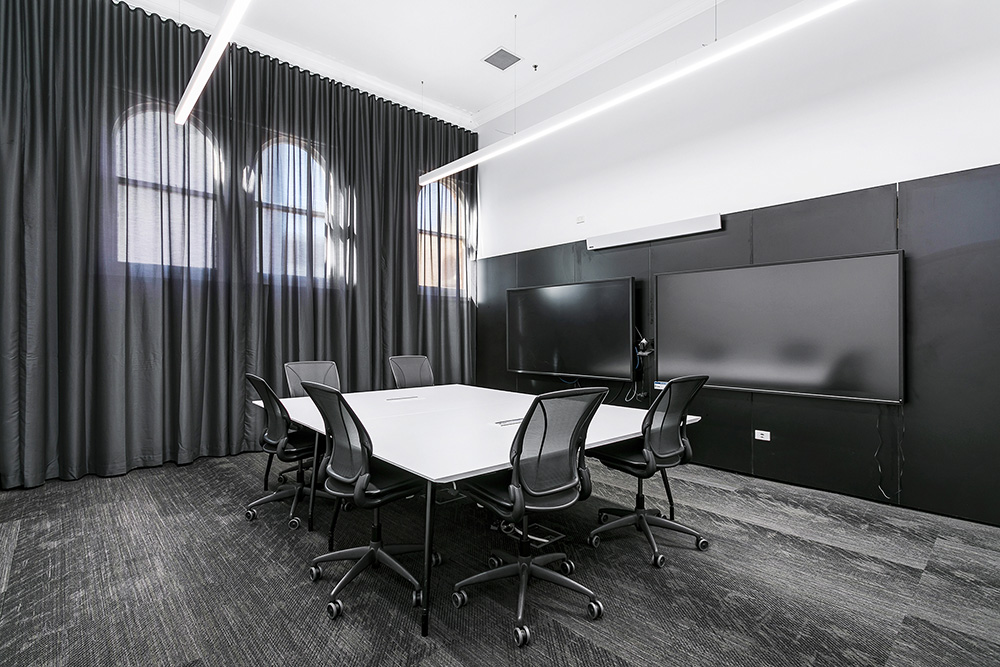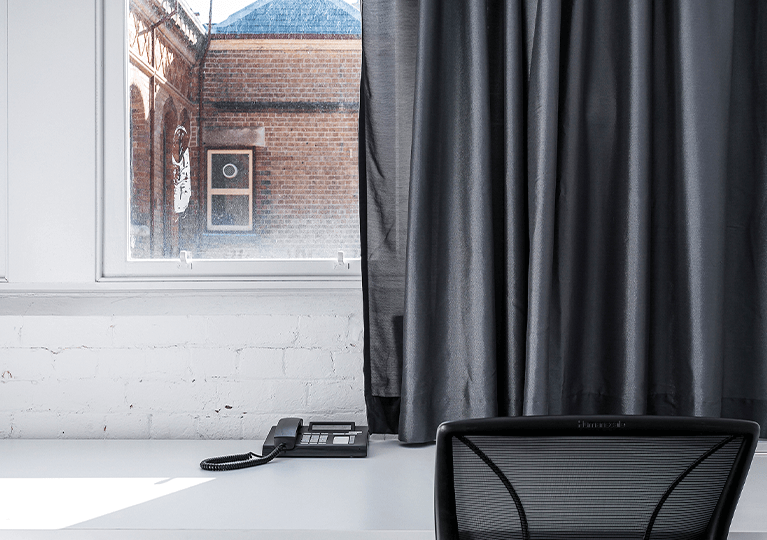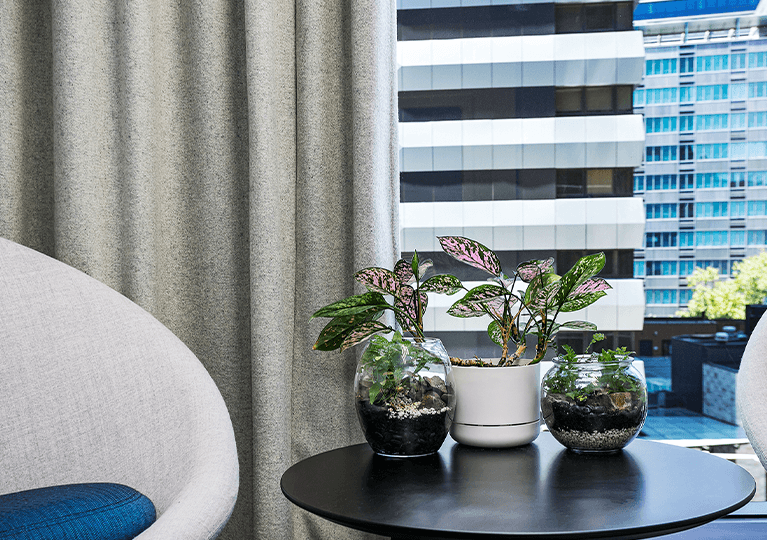Noise Problems, Considerations and Limitations
Across the globe, the health risks associated with excess noise are gaining attention. In 2018, the World Health Organization advised that urban noise poses a risk to public health and wellbeing.
Acoustic Blinds and Curtains solve two kinds of noise problem:
1. Noise reduction
2. Sound absorption
However Acoustic Blinds and Curtains cannot guarantee acoustic results (noise reduction or sound absorption) because every acoustic environment is different and results may vary.
Please read our considerations and limitations to decide if Acoustic Blinds and Curtains are right for you.

Noise reduction
Noise reduction refers to reducing the amount of outside noise coming in – commonly known as environmental noise or noise pollution.
Reducing noise and protecting indoor spaces from noise pollution is a requirement for healthy living environments - as well as being linked to cognitive performance and quality of life.
There are two causes of noise pollution in indoor spaces:
1. Volume of environmental noise
2. Inadequate acoustic treatment or insulation
Noise pollution is caused by an accumulation of environmental noise. The main sources of environmental noise in urban areas are transport (road, rail and air traffic), industries, construction, public works, and general neighbourhood activity. The volume of environmental noise is generally increasing with population growth and urbanisation.
Environmental noise then enters indoor spaces by the windows and other poorly sealed or insulated walls, floors and ceilings.
Acoustic Blinds and Curtains leading acoustic fabrics are specially designed to reflect and absorb sound energy to reduce the noise and improve the acoustics of any room.
However Acoustic Blinds and Curtains cannot guarantee acoustic results (noise reduction or sound absorption) because every acoustic environment is different and results may vary.
Please read our considerations and limitations to decide if Acoustic Blinds and Curtains are right for you.
Noise reduction considerations and limitations:
The type of noise
Volume (decibels)
- Acoustic curtains are most effective against louder (high decibel) sounds vs. quiet (low decibel) sounds (based on ‘perceived’ noise reduction)
- Acoustic curtains are least effective against ‘impulse’ sound, instantaneous sharp sounds e.g. a dog barking, and most effective against constant noise e.g. traffic noise
- NOTE Acoustic Blinds and Curtains are not 'soundproof'. In reality no acoustic treatment stops all sound. Acoustic Blinds and Curtains will reduce the noise - but it is important to have realistic expectations
Pitch (frequency)
- Acoustic curtains are least effective against low frequency sounds e.g. bass sounds, trucks, and most effective against high frequency sounds e.g. city noise
The room itself - specifically if there is a 'secondary source' - another, untreated source through which sound is entering the room
Windows
- Other, untreated windows
- Poor seals, including non solid seals e.g. mohair
Doors
- Glass or hollow doors
- Poor or no seals, including non solid seals e.g. mohair
Holes in the wall or ceiling
- Wall vents
- Penetrations in walls or ceilings e.g. electric outlets or communications port, large light fittings
- Weep holes for brick homes
Walls
- Lightweight walls e.g. weatherboard outside and standard plasterboard inside
- Lack of insulation in the wall cavity
- Walls layers with penetrations and/or gaps (potentially from age of building)
Ceilings
- Skylights
- Lightweight roof structure e.g. thin roof metal sheet with standard plasterboard ceiling separated by small air cavity e.g. less than 250mm
- Lack of insulation in the roof cavity
- Ceilings with exposed joists/rafters/purlins i.e. no ceiling layer
Installation
- Acoustic Blinds are not effective for noise reduction due to the gaps around the blind mechanism, which leads to sound leakage and a reduced noise reduction
- Acoustic Curtains need to fully cover the window or space. We recommend floor to ceiling and wall to wall for best results, and a minimum of 200mm overlap on all sides of the window to reduce sound leakage
- Room dividers - Acoustic Curtains can be used as room dividers – however in our experience, it is important to manage expectations. Acoustic curtains will provide significantly greater noise reduction compared to traditional curtains, but they will not provide the noise reduction of a wall


Sound absorption
Sound absorption refers to reducing reverberant sound in a space (commonly referred to as ‘echo’) to improve internal acoustics.
When a sound is created, it will bounce off hard, reflective surfaces such as glass and concrete. Reverberation time is the time required for sound to ‘fade away’.
A high reverberation time significantly impacts hearing and intelligibility.
Decreasing reverberation time improves internal acoustics.
There are two causes of high reverberation time in indoor spaces:
1. Too much reflective surface e.g. open plan rooms, hard concrete and wooden floors, large areas of bare solid surfaces e.g. windows, walls, ceilings (particularly parallel walls and high ceilings)
2. Not enough sound absorbing surface e.g. lack of soft furnishings such as soft chairs, blinds and curtains etc.
Acoustic Blinds and Curtains leading acoustic fabrics are specially designed to reflect and absorb sound energy to reduce the noise and improve the acoustics of any room.
However Acoustic Blinds and Curtains cannot guarantee acoustic results (noise reduction or sound absorption) because every acoustic environment is different and results may vary.
Please read our considerations and limitations to decide if Acoustic Blinds and Curtains are right for you.
Sound absorption considerations and limitations:
The type of noise
Pitch (frequency)
- Acoustic curtains are effective for all frequencies. However note that each fabric is most effective for a specific frequency range.
The room itself
- Acoustic Blinds and Curtains are less effective in rooms that are already highly sound absorptive e.g. have acoustic panels, lots of soft furnishings or carpet
- Acoustic Blinds and Curtains are less effective if there are other large, untreated reflective surfaces e.g. windows, walls, ceilings of bare solid surfaces such as glass, concrete, wooden floorboards (particularly untreated parallel walls and high ceilings)
Installation
- Acoustic Blinds and Curtains need to cover a sufficient proportion of reflective surfaces to be effective
